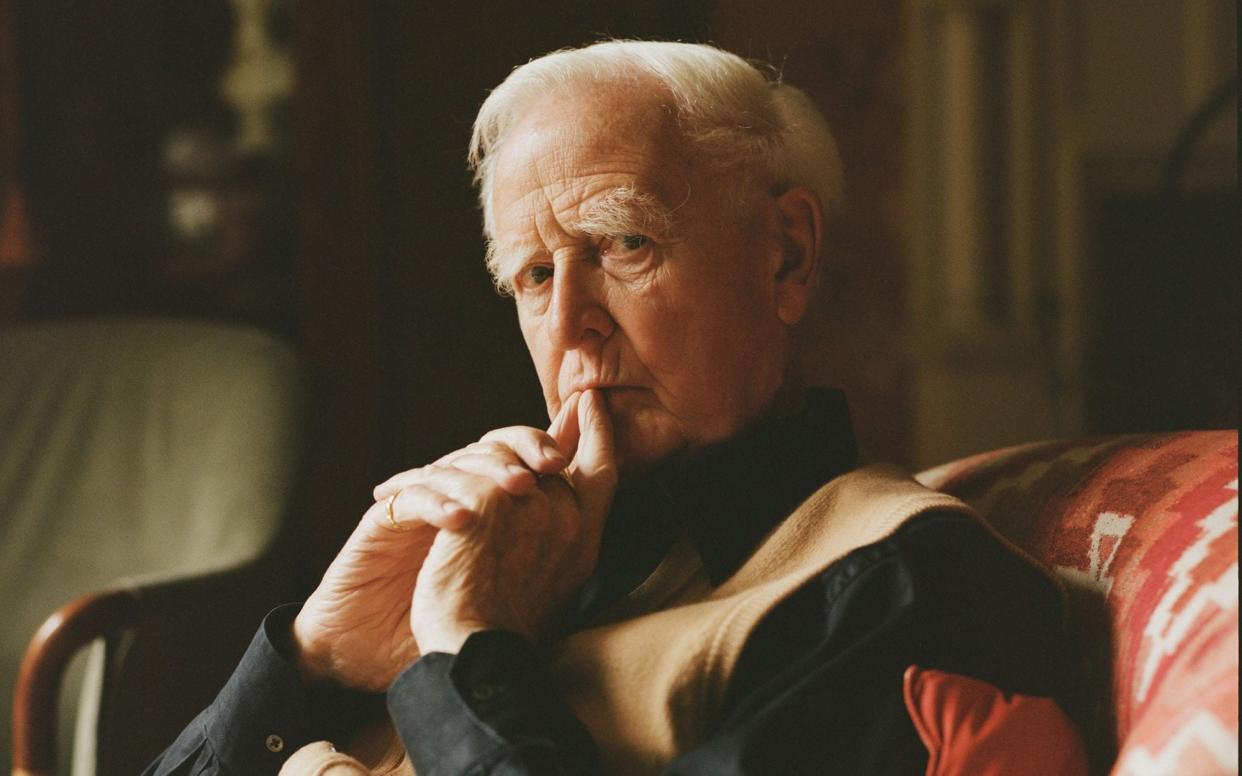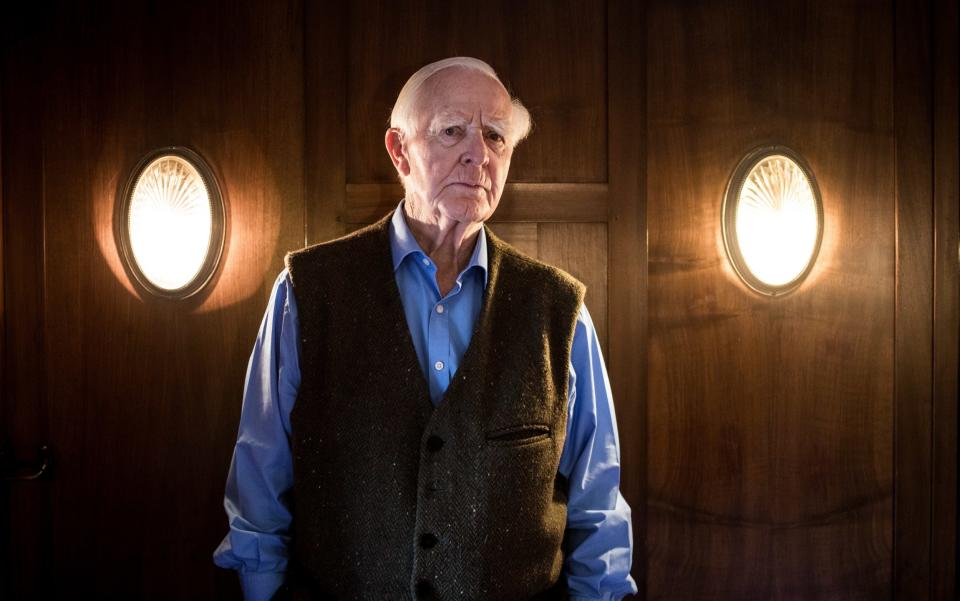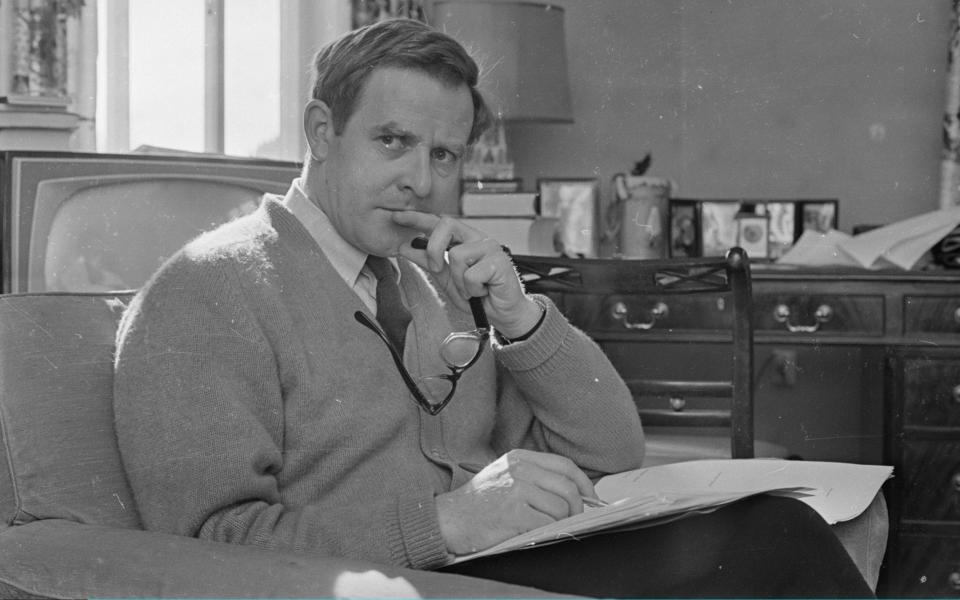John le Carré knew so much about my life, I started to think he was spying on me

- Oops!Something went wrong.Please try again later.
When I heard the sad news of John le Carré’s death, I remembered the many hours we spent together while I was writing his biography. For a period of several years, we would meet frequently, every couple of months or so, to talk about his past. Of course, I never met ‘John le Carré’; I knew him by his real name of David Cornwell.
Usually, I would visit him at his house in Hampstead, arriving in the late morning for a couple of hours’ interview before we would go off to a relaxed lunch together in a local pub, and then return to continue the conversation until I would depart in the early evening, fortified by several glasses of Armagnac.
It felt like good-humoured sparring, and I often felt that he was at least one step ahead of me. I recall one time when he remarked: “If I were writing my biography, the question I would be asking me now is…”
In particular, my mind went back to the occasion when I first visited his house in west Cornwall, in a dramatic and isolated position, perched high on the cliffs overlooking the sea. To reach it, you turned off a country lane and drove for about a mile along a grassy track towards the beckoning blue.
I arrived one April morning, and was welcomed by his wife, Jane, who set me up with a desk and a chair in the old garage that housed his archive. I was free to browse in the cardboard boxes and filing cabinets stuffed with his personal papers.
It was a glorious spring day, one of those when every living creature seems be bursting with vigour, so I left the garage door ajar to enjoy the background birdsong, the scent of newly emerged flowers, and the hum of insects.
After I had been there an hour or so, I was suddenly aware of a shadow against the sunlight, and I turned to see David, standing in the doorway, peering at me over his spectacles. “It’s very strange to have you here, Adam,” he said to me, with a smile, “poking about inside my mind.”
It was strange for me, too, to get to know intimately a writer whose work I had been reading, and admiring, for almost half a century: ever since I read The Spy Who Came In From The Cold, which must have been when I was about 12 years old, a few years after its publication in 1963. Indeed, it was one of the first adult books I read. It made an enormous impact on me at the time; this, I felt, was the real thing, honest and gritty.
The protagonist, Alec Leamas, is a troubled character: his outburst at the end of the book is a fervent protest against the bad things he has been asked to do in the service of his country.
“What the hell do you think spies are?” he asks his distressed girlfriend: “Moral philosophers measuring everything they do against the word of God or Karl Marx? They’re not! They’re just a bunch of seedy, squalid bastards like me: little men, drunkards, queers, hen-pecked husbands, civil servants playing cowboys and Indians to brighten their rotten little lives.”
This was a very different depiction of spying from the one presented in Ian Fleming’s bestselling novels. The moral ambiguities of The Spy Who Came In From The Cold are in marked contrast to the unquestioning certainties of the James Bond books, in which the goodies and baddies are clearly delineated. To readers in the early 1960s, accustomed to the messy compromises of the Cold War, they seemed far more truthful.

Similarly, le Carré’s squalid settings seemed more realistic than the glamorous five-star hotels, high-rolling casinos and expensive restaurants frequented by 007. Overshadowing the novel is the image of the Berlin Wall, in all its stark, inhuman brutality: “a dirty, ugly thing of breeze blocks and strands of barbed wire, lit by cheap yellow light, like the backdrop for a concentration camp”.
In 1961, David had seen the wall for himself, only months after its construction began. He would later describe his feelings of disgust and terror, which he decided was exactly what he was supposed to feel: “The Wall was perfect theatre as well as the perfect symbol of the monstrosity of ideology gone mad.”
The Spy Who Came In From The Cold opens at the Wall, when a man is shot while trying to cross over to the West, and closes there, with two more corpses lying at the Wall’s foot, raked by searchlights. It was a worldwide bestseller, reaching no 1 in the US and remaining there for 35 weeks, becoming the bestselling novel of 1964. In the process, David reinvented the spy novel.
The New York Times reviewer praised The Spy Who Came In From The Cold as “both as a compelling and dazzlingly plotted thriller and as a substantial and penetrating novel of our times”, acknowledging that the book had raised the genre to a higher level: it was “a light year removed from the sometimes entertaining trivia which have (in the guise of spy novels) cluttered the publishers’ lists for the past year” – perhaps a reference to Ian Fleming’s On Her Majesty’s Secret Service, which had been a fixture on the American bestseller list for the previous six months or so.
This was one of several reviews to suggest The Spy Who Came In From The Cold had rendered James Bond obsolete; in fact, Fleming died of a heart attack within a few months of its publication.

In subsequent novels, particularly the three written in the 1970s that make up The Quest for Karla trilogy (Tinker, Tailor, Soldier, Spy, The Honourable Schoolboy and Smiley’s People), le Carré established himself as the quintessential novelist of the Cold War – so much so, that when it ended, at the end of the 1980s, there was a widespread perception that he had lost his subject.
Friends stopped him in the street to commiserate. “Whatever are you going to write now?” they would ask. To some extent, David was a victim of his own success. To most people, the name John le Carré was by then synonymous with the Cold War; more than any other writer of his generation, he had shaped the public perception of the struggle between East and West.
“I saw the Berlin Wall go up when I was 30, and I saw it come down when I was 60,” David told one interviewer. “I was chronicling my time, from a position of knowledge and sympathy. I lived the passion of my time. And if people tell me that I am a genre writer, I can only reply that spying was the genre of the Cold War.”
The strong sense of authenticity emanating from le Carré’s books is enhanced by the use of what appears to be the jargon of the spy world: ‘the Cousins’ (Americans), ‘the Competition’ (MI5), ‘scalphunters’ (specialists in dangerous operations), ‘babysitters’ (bodyguards), ‘pavement artists’ (agents conducting surveillance), and so on, giving the reader the impression that he or she is being taught a secret language. The effect is ironic, because though some of this jargon is real, much of it is invented.
In a further twist, some of David’s coinages have subsequently been adopted by intelligence professionals. For years, after his initial success, le Carré denied that he had any inside knowledge of spying, but gradually it has emerged that this was a cover story. The truth was that he had worked for MI5 in the late 1950s, before transferring to MI6, where he was stationed in West Germany.
Earlier still, as an Oxford undergraduate, he had spied on his fellow students. In his early career as an intelligence officer, he had run agents and conducted interrogations: he knew what he was writing about.
The habits of tradecraft stayed with him, long after he had left the service. Often, when we met, he would unsettle me by disclosing that he was aware of some development in my personal life. I began to suspect that he was spying on me; just as, in another sense, I was spying on him.
John le Carré: The Biography by Adam Sisman is published by Knopf Canada. To order your copy, call 0844 851 1514 or visit the Telegraph Bookshop
Read more: John le Carré: the 10 best adaptations of his work
Read more: John le Carré: where to start reading, and 10 of his best novels

